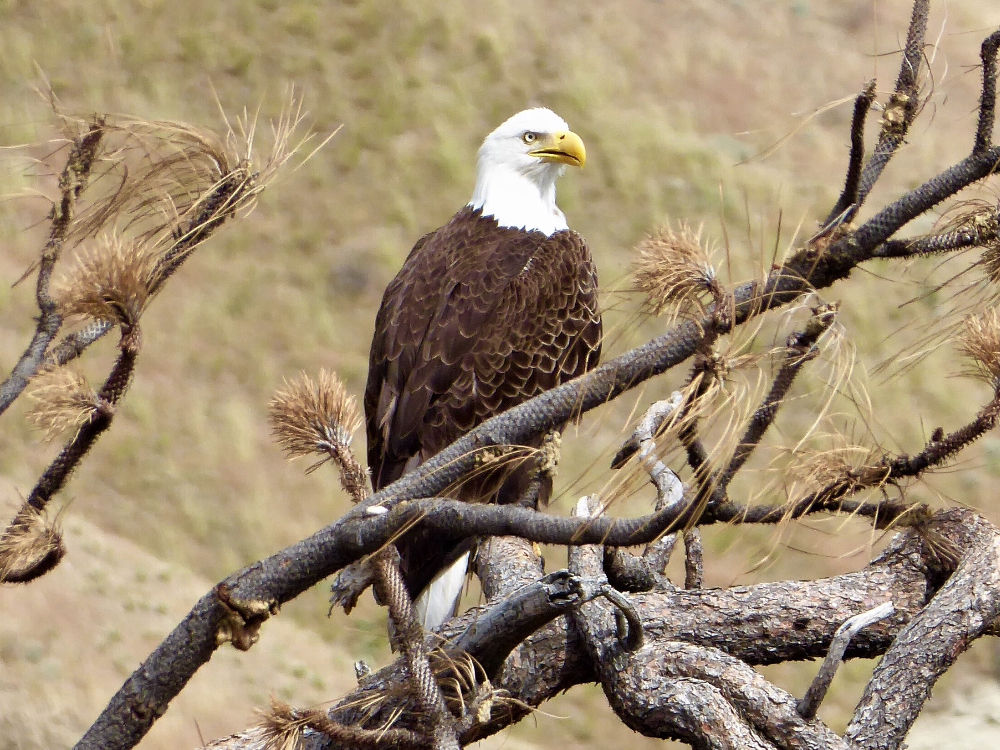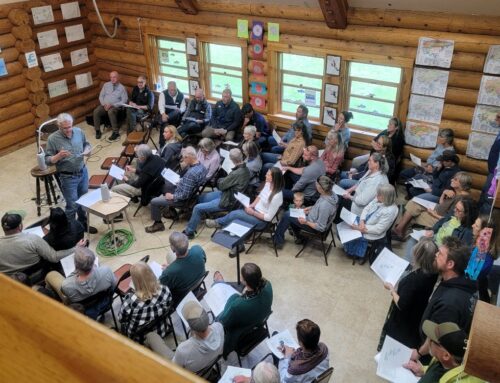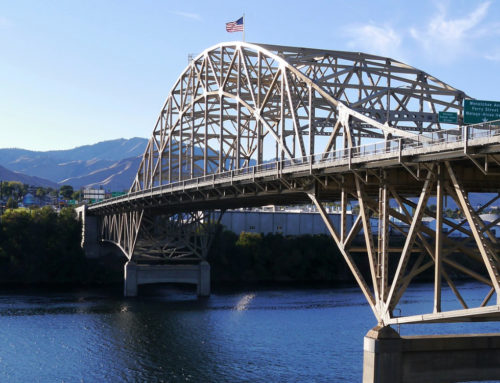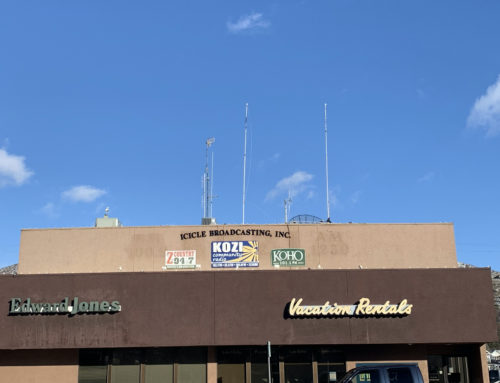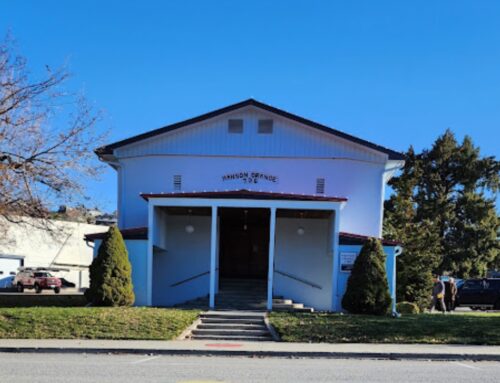After Decades of Protection, the Bald Eagle has Recovered from Near Extinction
by Loni Rahm, with photo by Brian Patterson – taken near the Chelan Airport
The photo (above) we received yesterday from Manson resident Brian Patterson was so stunning and such a perfect highlight for our Nation’s Birthday, we just had to use it. But the picture also spurred my curiosity – are Bald Eagles still an endangered species?
I will never forget the first bald eagle I saw in the wild. And quite frankly, I’ve never stopped being fascinated by this stately bird no matter how many I see, nor how frequently.
The Washington State Fish & Wildlife Department consider the recovery of the bald eagle to be a major success story for our state and the entire nation.
After 30 years of steady population growth, the iconic bird was removed from the federal endangered species list in 2007, then from the state’s list in 2017. Scientists attribute the species’ dramatic recovery to a variety of conservation measures, notably the federal ban on DDT.
Now that bald eagle populations have rebounded, many of the special safeguards designed to protect them are no longer necessary. Since 2011, when the Washington Fish and Wildlife Commission changed the species’ status from “threatened” to “sensitive,” many of the state’s special protective measures for bald eagles have been eliminated.
Today, the U.S. Fish and Wildlife Service (USFWS) has the primary responsibility for managing bald eagles under the provisions of the federal Bald and Golden Eagle Protection Act and the Migratory Bird Treaty Act. Current federal guidelines for activities that may affect bald eagles are posted on the USFWS website.
How the public can help protect bald eagles
While bald eagles are no longer classified as an endangered species, their future will nonetheless depend on human policies and activities. People can help to safeguard the species in several ways:
- Give eagles a wide berth: Federal and state laws prohibit killing, injuring, or disturbing bald and golden eagles without a permit. National guidelines issued by the USFWS recommend ways to avoid interfering with eagles while engaging in such activities as timber operations, construction projects and off-road vehicle use.
- Check permit requirements: While bald eagle recovery has reduced the need for special protections, some activities such as removing an eagle nest or possessing eagle feathers still require a federal permit. Some county and city governments may also require self-certification of compliance with the national guidelines as a condition of issuing a local land use permit.
- Report injured bald eagles: If you find an injured bald eagle, you are encouraged to report it to a certified local eagle rehabilitator or to wildlife agencies listed on the USFWS website.
- Report dead bald eagles: Federal wildlife managers also want to recover the carcasses of dead bald eagles, especially if they appear to have been shot, poisoned, or otherwise killed intentionally. In those cases, the federal agency asks that people call the USFWS office in Redmond (425-883-8122) as soon as possible. The agency’s website provides additional guidance.
Federal responsibilities for bald eagles
As the lead management agency for bald eagles, the U.S. Fish and Wildlife Service is the primary source of public information about the species in Washington state. General information about bald eagles is available on the agency’s website and its Bald Eagle Information Line (360-534-9304).
USFWS’s key responsibilities for bald eagles include:
- Enforcing federal laws that protect bald eagles in conjunction with state law enforcement.
- Granting permits for activities that affect bald eagles, in accordance with federal regulations.
- Issuing federal permits that authorize the care of sick and injured eagles, and helping citizens locate a certified eagle rehabilitator if they find an injured eagle.
- Authorizing permits that allow eagles (alive or dead) to be used for purposes ranging from scientific collections to Native American religious ceremonies.
- Assisting citizens with the disposition of eagle carcasses.
State responsibilities for bald eagles
The Washington Department of Fish and Wildlife’s responsibilities have changed with the recovery of the bald eagle in our state. The department’s role now includes:
- Enforcing state and federal laws to protect bald eagles in conjunction with federal law enforcement agencies.
- Providing state permits and support for local wildlife rehabilitation facilities that care for injured bald eagles
- Helping to inform the public and local governments about current regulations and assistance available for situations involving bald eagles.
- Monitoring bald eagles as needed to determine the species’ population status.
Today, the department is NO LONGER INVOLVED in the following management activities:
- Developing and reviewing bald eagle plans for specific properties.
- Producing Priority Habitat and Species maps showing bald eagle nests, roosts and foraging areas.
- Notifying applicants for forest practices permits of bald eagle nests or roosts in project areas.
- Taking individual reports of bald eagle sightings, nests and communal roosts. The public can now report this information on a website where WDFW, and other agencies and researchers can access this data when needed.
Local governments’ responsibilities for bald eagles
Local governments should comply with the federal guidelines for actions – such as removing a tree or building a road – that have the potential to disturb eagles. Some counties and cities also protect bald eagles using their land use regulatory authority under the Growth Management Act and Shoreline Management Act. In those cases, local jurisdictions may choose to require project proponents to certify they are in compliance with federal bald eagle guidelines as a condition of local permit approval.
The USFWS encourages local governments to review the national guidelines and use the agency’s self-certification tool if an activity is unlikely to disturb eagles or take an eagle nest. The USFWS does not recommend local governments require a written statement from the USFWS that “no permit is necessary.” These determinations cannot be made outside the permit process, which is not appropriate for all projects. For more information, contact the USFWS.
Developers’ and foresters’ responsibilities for bald eagles
Private project proponents are also advised to consult – and follow – the federal guidelines any time they plan to take an action that could disturb a bald eagle. The guidelines not only describe precautionary actions recommended by USFWS to avoid disturbing eagles, but also clarify when a federal permit is required.
Project proponents should also be aware that county or city land use regulations may require them to confirm to the local planning department that they are in compliance with federal requirements.
Other information:


